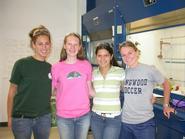
Four students will continue a long-term research project titled "Silica Sol-Gels Containing Rare Earth Ion Chelates" at Hamilton College this summer as science researchers. Advised by Associate Professor of Chemistry Karen Brewer, Jodi Raymond '08 (Camillus, N.Y.), Kim Roe '08 (Maryville, Tenn.), Elizabeth Faroh '08 (Bradenton, Fla.), and LeAnne Pasquini '07 (Kingwood, Texas) will continue an investigation of the optical properties, the synthesis and spectroscopy of rare earth based solid materials. (Another student, Louisa Brown '09, an incoming freshman participating in the Hamilton National Science Foundation's STEP (Science Talent Expansion Program) and the Henry and Camille Dreyfus Foundation Program, will join their research group later this summer.)
The goal of the project will be to enhance the amount of fluorescence given off by the rare earth. Each student has different responsibilities after they initially synthesize chelated compounds of the rare earth ions europium (Eu) and terbium (Tb) and look at their fluorescence properties.
Raymond, Faroh, and Brown are synthesizing other chelated complexes. According to Professor Brewer, Brown will be investigating the chelation of various diketone molecules to the rare earth ions; Raymond and Faroh will be synthesizing and studying macrocyclic crown ether and EDTA rare earth complexes. They will place chelated compound in a sol-gel by reacting water with TMOS (the substance that will form the gel). "After this the gel is given time to dry and the water evaporates, leaving the chelated rare earth ion protected from other rare earth ions and from OH groups in the gel," Raymond explains.
"[The group is] looking to increase the "glow of the rare earth ion by surrounding it with a protective chelating molecule. The optical properties of the rare earth ions (how they interact with light) has found use in laser materials, fiber optic networks, and phosphors for digital displays," Brown explains. When placed in extreme heat, the gels will turn into glass. Raymond, Faroh and Brown will investigate how this glass fluoresces; this reaction could ultimately help in creating more powerful lasers.
Rising junior Leanne Pasquini and rising sophomore Kim Roe have a slightly different role. They are both working to attach large organic molecules, called calixarenes, to the rare earth ion metal centers. "The idea is that the calixarenes will absorb UV light and transfer the light energy to the metal center to enhance the fluorescence of the Eu or Tb by the antenna effect. Since the calixarenes are so big, we are hoping they will shield the rare earth center from hydroxyl groups, which quench the fluorescence intensity, and prevent clustering of the rare earths." Pasquini says.
Pasquini prepared for this project by working on making simpler complexes with smaller ligands (molecules attached to the metal center) and making sol gels. "The sol gel process is a way of making glass, but instead of the typical method of heating sand up to very high temperatures and then cooling quickly, we make solutions and heat them up slowly to 90 degrees Celsius in the incubator and then up to 1000+ in the oven, which removes all residual water. (Residual water can limit the intensity of fluorescence.)"
Raymond, Pasquini, and Kim became interested in Sol-gels and rare earth metals after taking a class with Professor Brewer. Raymond admits that she was really interested in the research Professor Brewer had advised in the past, and was eager to conduct more research that would branch off of this previous work.
All have enjoyed their time researching at Hamilton this summer. For Raymond, the best part of summer researching is the lack of stress and distraction in the laboratory. For Kim, she enjoys the relaxing atmosphere on-campus during the summer. "The Chemistry department is great and the professors are very supportive of each of our individual projects. It's a great opportunity to spend time in the lab," Pasquini explains.
-- by Emily Lemanczyk '05
